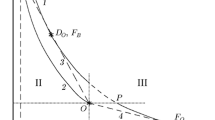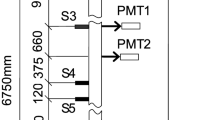Abstract
In the frame of industrial risk and propulsive application, the detonability study of JP10–air mixtures was performed. The simulation and measurements of detonation parameters were performed for THDCPD-exo/air mixtures at various initial pressure (1 bar < P 0 < 3 bar) and equivalence ratio (0.8 < Φ < 1.6) in a heated tube (T 0 ~ 375 K). Numerical simulations of the detonation were performed with the STANJAN code and a detailed kinetic scheme of the combustion of THDCPD. The experimental study deals with the measurements of detonation velocity and cell size λ. The measured velocity is in a good agreement with the calculated theoretical values. The cell size measurements show a minimum value for Φ ~ 1.2 at every level of initial pressure studied and the calculated induction length L i corresponds to cell size value with a coefficient k = λ/L i = 24 at P 0 = 1 bar. Based on the comparison between the results obtained during this study and those available in the literature on the critical initiation energy E c, critical tube diameter d c and deflagration to detonation transition length L DDT, we can conclude that the detonability of THDCPD–air mixtures corresponds to that of hydrocarbon–air mixtures.
Similar content being viewed by others
Abbreviations
- d :
-
tube inner diameter
- D :
-
measured detonation velocity
- D CJ :
-
Chapman–Jouguet detonation velocity
- DDT:
-
deflagration to detonation transition
- E c :
-
critical initiation energy of a spherical detonation
- L i :
-
induction length
- L DDT :
-
DDT Length
- P :
-
pressure
- T :
-
temperature
- THDCPD:
-
tetrahydrodicyclopentadiene
- u :
-
particule velocity
- CJ:
-
Chapman–Jouguet state
- ZND:
-
Zel’dovich–von Neuman–Döring state
- 0:
-
initial state
- λ :
-
detonation cell size
- Φ :
-
equivalence ratio
- ρ :
-
density
- σ :
-
Standard deviation of λ
- τ i :
-
induction time
References
Auffret, Y.: Etude de la détonation de mèlanges gazeux température initiale élevée. PhD Dissertation University of Poitiers (1998)
Austin J.M. and Shepherd J.E. (2003). Detonations in hydrocarbon fuel blends. Combust. Flame 132: 73–90
Bauer P., Brochet C. and Presles H.N. (1984). The influence of initial pressure on critical diameters of gaseous explosives mixtures. Prog. Astronaut. Aeronaut. 94: 118–128
Beeson H.D., McClenagan R.D., Bishop C.V., Benz F.J., Pitz W.J., Westbrook C.K. and Lee J.H. (1991). Detonability of hydrocarbon fuels in air. Prog. Astronaut. Aeronaut. 133: 19–36
Bull D.C., Elsworth J.E., Shuff P.J. and Metcalfe E. (1982). Detonation cell structures in fuel/air mixtures. Combust. Flame 45: 7–22
Card J., Rival D. and Ciccarelli G. (2005). DDT in fuel–air mixtures at elevated temperatures and pressures. Shock Waves 14: 167–173
Desbordes D. (1988). Transmission of overdriven plane detonations: critical diameter as a function od cell regularity and size. Prog. Astronaut. Aeronaut. 114: 170–185
Desbordes D., Guerraud H.L. and Presles H.N. (1993). Failure of the classical dynamic parameters relationships in highly regular cellular detonation systems. Prog. Astronaut. Aeronaut. 153: 347–359
Dubois, C., Ringuette, S., Stowe, R.: Evaluation of modified JP-10 fuels for pulsed detonation engine. AIAA Paper A02-26684 (2002)
Elsworth J.E. and Eyre J.A. (1984). The susceptibility of propene-propane/air mixtures to detonation. Combust. Flame 55: 237–243
Kaneshige, M., Shepherd, J.: Detonation database, Technical Report FM97–8, GALCIT, July 1997. http://www.galcit.caltech.edu/detn_db/html/
Kee, R.J., Rupley, F.M., Miller, J.A.: Chemkin II: a fortran kinetics package for the analysis of gas-phase chemical kinetics, Sandia National Laboratory Technical Report SAND89-8009. Reprinted August 1993
Li S.C., Varatharajan B. and Williams F.A. (2001). The chemistry of JP-10 ignition. AIAA J. 39: 2351–2356
Manson, N.: Contribution l’étude de la propagation des détonations et des déflagrations dans les mélanges gazeux. PhD Dissertation, University of Paris (1946)
Matsui H. and Lee J.H. (1978). On the measure of the relative detonations hazards of gaseous fuel–oxygen and air mixtures. Proc. Comb. Inst. 17: 1269–1279
Mitrofanov V.V. and Soloukhin R.I. (1965). The diffraction of multi-front detonation waves. Sov. Phys. Dokl. 9: 1055–1058
Peraldi O., Knystautas R. and Lee J.H.S. (1986). Criteria for transition to detonation in tubes. Proc. Comb. Inst. 21: 1629–1637
Pinard P.F., Higgins A.J. and Lee J.H.S. (2004). The effects of NO2 addition on deflagration-to-detonation transition. Combust. Flame 136: 146–154
Reynolds, W.C.: The element potential method for chemical equilibrium analysis: implementation in the interactive program STANJAN, Version 3, Department of Mechanical Engineering, Stanford University, Palo Alto, California (1986)
Sorin, R.: Etude et optimisation de la transition déflagration détonation en tube des mélanges stoechiométriques H2/O2/N2 et (CH4, C2H2, C2H4, C3H8)/O2/N2 et de sa transmission à un espace de plus grande dimension, PhD Dissertation, University of Poitiers (2005)
Sorin R., Zitoun R. and Desbordes D. (2006). Optimization of the deflagration to detonation transition: reduction of length and time of transition. Shock Waves 15: 137–145
Hewson J.C. and Bollig M. (1996). Reduced mechanisms for NOx emissions from hydrocarbon diffusion flames. Proc. Combust. Inst. 26: 2171–2179
Westbrook C.K. and Urtiew P.A. (1982). Chemical kinetic prediction of critical parameters in gaseous detonations. Proc. Comb. Inst. 19t: 583–590
Williams, F.A.: http://maemail.ucsd.edu/combustion/cermech/JP10-Reactions/
Zel’dovich Y.B., Kogarko S.M. and Simonov N.H. (1956). Etude expérimentale de la détonation sphérique dans les gaz. Z.E.P.T. 26: 1744–1772
Zhang, F., Murray, S.B., Gerrard, K.: JP-10 vapor detonations at elevated pressures and temperatures. In: Proceedings of 18th ICDERS, Seattle (2001)
Author information
Authors and Affiliations
Corresponding author
Additional information
Communicated by F. Lu.
This paper is based on the work presented at the 33rd International Pyrotechnics Seminar, IPS 2006, Fort Collins, July 16–21, 2006.
Rights and permissions
About this article
Cite this article
Sorin, R., Bauer, P. & Desbordes, D. Detonability of THDCPD-exo–air mixtures. Shock Waves 17, 363–369 (2008). https://doi.org/10.1007/s00193-007-0117-7
Received:
Revised:
Accepted:
Published:
Issue Date:
DOI: https://doi.org/10.1007/s00193-007-0117-7




